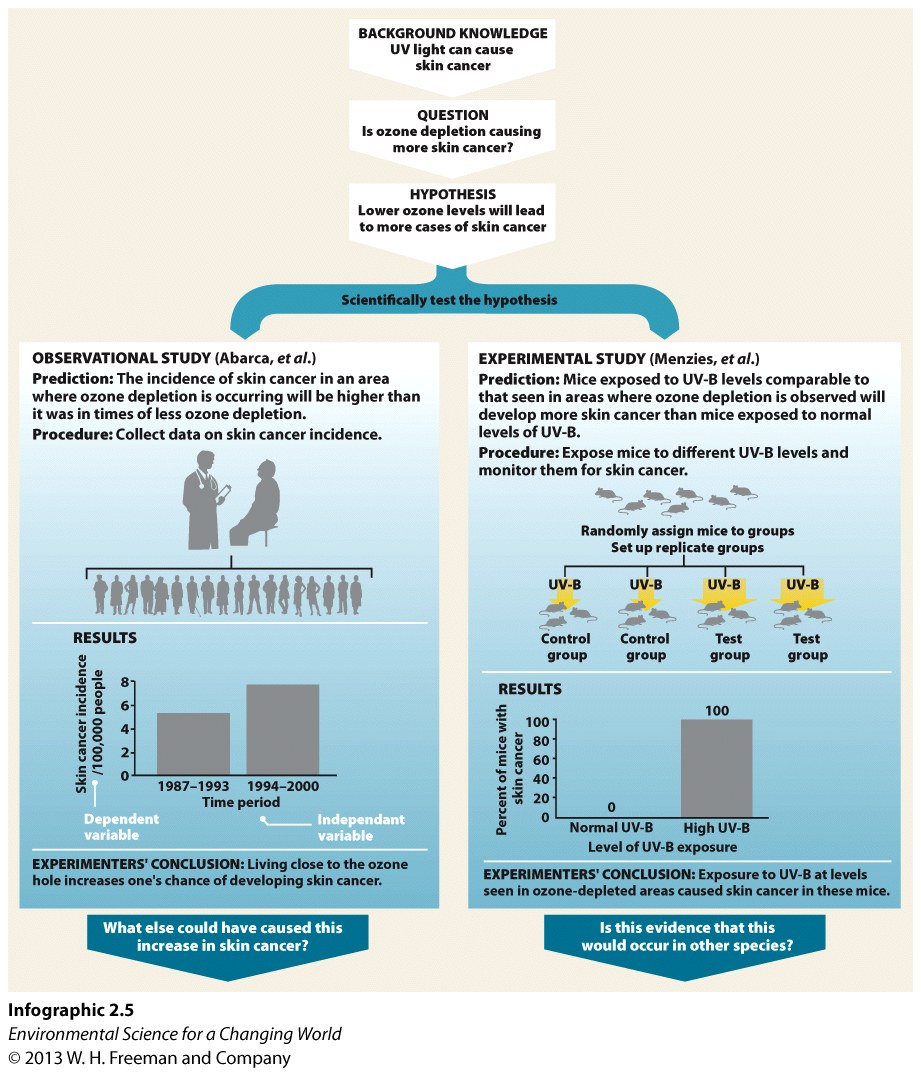Chapter 2. Chapter 2: Science Literacy and the Process of Science
How are scientific hypotheses generated and tested?

Guiding Question 2.2
How are scientific hypotheses generated and tested? What are the two main types of scientific studies, and why do we need both types?
Why You Should Care
Understanding how scientists form and test hypotheses will help you understand scientific information in your daily life. Whenever you watch the news and hear that Food X causes cancer, you shouldn’t accept that as fact. Instead, you should consider the science behind the news story. A group of scientists must have suspected that Food X might cause cancer and tested this hypothesis. But what kind of study did they eventually use? What if the findings by the scientists were from a completely observational study, such as a survey to determine how many cancer patients consumed large amounts of Food X? If this were the case, then only a connection between cancer and Food X can be made. It would take an experiment for the researchers to claim that Food X causes cancer.
Question Test Your Vocabulary
Choose the correct term to match each of the following definitions:
| Term | Definition |
|---|---|
| LFT0lfYRxmTmQEP8YAo18vX6VmReT1w7jVbALNZahzzis3NrM2+Gc6wbH2GmYKy9BOZXKPsffw77SvuXonQjdEW/XAi44VS7629imfcLCfPpozucXf9s2A== | The procedure scientists use to empirically test a hypothesis. |
| XTpfpKCPEfM/b8eO/dQ8xDdHqmAZ37BEgt2g7j05Jq7DNs/H3JH+c8yFOog7dcN7Wy6rX16HhCqidMHNDHnpeRDaijJP6KjV2AVv+XE5xZE4Vnx6voRvOQ== | A possible explanation that generates predictions for which empirical evidence can be collected to verify or refute the hypothesis. |
| X/iy9tpu3O0/aiyfmx/qE6blcKDITFU10JKxMzTvw7ArfHuQZBORiL8N4EylUTUEukk4789Qnr7N6jNnyNZ9MKMvZjJBi6aLGtbvM0anSlo2LhecSm9jXg== | An idea or a prediction that can be proved wrong by evidence. |
| C5XbH+D65wXoKiMUy8tHtC/7eW2JySfgtABt6tsF+s1ql2Gcg8mHf3Tm/oVJqknFMbtvbZY3zBrDKs9esQwc2lnFuTRexvPzFGFFgQs5foh9hAAYU75CHw== | A widely accepted explanation of a natural phenomenon that has been extensively and rigorously tested scientifically. |
| wvH9qfNwHdGB2LqI30B4y6LNIqWwlBwVugmqv1diWwk8YHmFWHVpO7YkR1+70HvZcR9rP4YOKdY3A0dEfwGSINpxeOOKANP1+EWWKMj5TzUdm6MOTQrBoQ== | A possible explanation for what we have observed that is based on some previous knowledge. |
| t/aweDB9LEsMsLADW1tM/LyLQYHCn9S0Sr4cRV6N6qkiF3sVOhMBmMvgQyGtvGXnUwrB7Hj6XHFiSk9KI0RqSjS8aHsrsyDTSqBlUA8eBgRxKW0najSddg== | A statement that identifies what is expected to happen in a given situation. |
| YQNRGB27ue3zzsCuW49hhyKuyFa5RL2IBlCo2IK8BtHCSOzpQ4229iJFijiUIl6dFqnZwjndiB3uifL3+XkvX5xQbvqzEiicBzzAGPLETfoTfoIPNAbbHg== | Researchers submit a report of their work to a group of outside experts who evaluate the study’s design and results of the study to determine whether it is of high-enough quality to publish. |
Question 2.1
V1i+vaMmVIxlvvkrhXuZhzD4IPnP33xaUa20+OREUbwpTesNXekoHojGZIYvhklCs/JYLhBqTLr0ej91OWuexPoyCR7iQ1eahe3SPFnuT0Av4z8MKEBOMBvHrlwIBy9oBMHy77j3yyBW7zERElswcNaTqW/wW1Pvq/KbCFY2gpfZyfZOPs3npWyyUEt4yjsaN7AyKE61AY0GlmHIXkbEW3b9FOfeobppvipk6pU+T+EFzcc5kI+FrlBAs3W6TXTb/3EUTJ1ZPjo7GeLvZv0tQjITbF0/XuMmbNKbmANJDZNOoWMcTiwuwNZJFcUQB86RTP1J2l9/3Mzz61IE8Qkolx2on5zwV3QVlYet1o4o8YGdzyJxN1zoL1tuvhmv+cfHuyhAvF18ggX9dIOQQWRn2q5NrO9jkaTTxszFy6xBcsp9m04QefljfXzfN7lBK516nuZIZfe8iUOh8O5VSjtSVwd32/OQi9rE5bPPJYFCfwNgDpUWOoMhkshlkGCaQw/G5a6R1YiAZyg=Question 2.2
+U0va0S9J4Wi/ppEpVxeA97Ev747QEmCSoLK9VmLy/tTAHqqIuThD93trYdLQkV4JtGolEjWSaqLO4u1ADcgyDAIZQU=To complete the activity below, click on a label at the bottom, then click the question mark icon on the Infographic where it belongs.

Question Sequence
Question 2.3
+gELotS0be6M76Nfmb8SJ4fP5866n5shr6OP6b1PsE0eTNyyqEJ3hAV5pTteXgV2uTU0QObveFEX2L69bLP9h2Aak5WGJQFpZdZWUASrTCmkqLQrPe22EfhpfQNHWavZkZZBwl179CUy/U1OMOmSTEfTa6mX/uVvTFP1peIjoHOIRZoIwlzGq1mJC4WR3LjXVZL3EtRg0fczmj7F7i5C7y1SqRz5WEif0Zvg4lK7jeMb61J8t0YHJWTbqrGVRpGF192mkwwQwWuX1MruyXIZhcw8H2+c9a7UmfO8dRWZYgU60HeovJq4c7VCxQxe1u55+GVW0dGl1nyUy+CoJWs1+rN1SZTk3GiPOaiH5k87Kz3fSTm65A0LyPkeukTt89KVjoNg47F/2BIv9YjeuQK6Ck5wDyZh+7ENF4ZXUyAgx97h+PLEtgY5yiHgPLQtLEgvnUUrvWMSwojk6FNWZFY/xPo6q5CUDtnBHpX5IQ==Question 2.4
NNYQMNZyYfJ1tNQInrsw24G1HCWZwVezFtcb7oCBxT6GVz5FQuestion 2.5
OfMwlfX/vU3YVTnCYwPkdUgGXf9jMO75T12li769slkQS2ZK5T3pWUGQtCoQAe6+6WtDqRfLh9xe3ZDypWIge55ofGSyEx2oz59koh3umP7XWJf/zOEGLgcN7FNqJQPXtTeymSM6714=
Question Test Your Vocabulary
Choose the correct term for each of the following definitions:
| Term | Definition |
|---|---|
| UiN27hQKPcvtGsgaNudf6bIOO6lr8ZLm8hXcG1mf/IRa/GpFbxjBcxM+0WET0at/IF7oOGRNS+BjijW1ksysWDf9y0LGLD/efvjpKwDC2N4A3O45nyX+MhoUiLkRmFG7baAwXbHw5vfIcNOPwCDVYw== | The group in an experimental study to which the test group’s results are compared; ideally, the control group will differ from the test group in only one way. |
| rW8sGy62eg5U4vgoKRKiPjRR5gRGwqXuCAHqheElrgGVP8ovvkxUdv+pmeNL/V3qeFkremM39wrB5I8oU5gD9oXrTAfrca7/t4a9jliyRHbqvsKjkaDSK/dc1eHE0IhnFbFAuZaGH3c0kguUj57MmA== | The variable in an experiment that is evaluated to see if it changes due to the conditions of the experiment. |
| 9E0Y1TtgCeg0igsLH9b2xr4S75EFxuj8A0GoRZuTTCk8LS2kkp/thpZVq+6Ge+hqM/8X+itSzVGMlR6RUW+du3Hu07tz3pnbmqalthbk88XeV/ddkZkf1DZojT5etT1cXGWAI5c7tMl3FMXNvCunRA== | Research that gathers data in a real-world setting without intentionally manipulating any variable. |
| p39gVU+pMJcZw/3ODUDUyTucytPXphkzIrqchj5r0BJnJsRjgGY7FcpFjMK8nmtVjlrTBLAJvdA6ypnBZC0dvlx9Ny+dYCZfoSqS/QqxPe/Ob+Xu0ry+h2QNnw+oYigX5/XVwE8sofGIadVjrlzH3Q== | The group in an experimental study that is somehow manipulated such that it differs from the control group in only one way. |
| RN4krGoRkEC/X7bGMCsBzZo6cZkWF0PsAsZc0RYFgDv8a+Vb9fdcUrZjK+IUtWWJOp9Q/fnTc0oBYeuFICcyFRPZ3/KE+3TgrQKvJ1U+/PjLgKi2m8AKCUdwpt2Nj+OBcC23u3pBdCH45NpEhPLxnA== | The variable in an experiment that the researcher manipulates or changes to see if it produces an effect. |
| mjXzlok1fTnf/p6praxBqKutwxzPRWUwXFWPpmEEiPsCbEkxkLmlMIFlgyOPVQ2iRj/jqsnDBNGAawXSQgQZEBR4viB/peVhqBYife2gKxQ0DYWxb8vljtIFlfMJb0qftcG0h9xptp4Qw4NkDU+WBw== | Research that manipulates a variable in a test group and compares the response to that of a control group that was not exposed to the same variable. |
Question Sequence
Question Sequence
Read the description of each study below and decide whether it is experimental or observational:
Question 2.6
Scientists want to know what the typical lifespan was for an ancient Egyptian. After finding a burial ground with several hundred graves, the scientists use measurements of several different bones and teeth do determine the age at death. They then were able to calculate the average age at death and estimate life-expectancy.
K0N0v9ve0JtVBVC+DbproIE/t7r+q3yOXAc/TIS7urV+j7qQ3rxm5hGFC5KcOfbKAz5RPWwbMy+uYkG66juYsNzA/lmzTh+OUP/PREa9285FqfnE73ehMvHga8B0RfzKieGQneYHBeWITbSzQuestion 2.7
Researchers are interested in knowing whether chipmunks decide what sort of food to eat based on how efficiently they can gather it. They make up peanut-butter-and-flour balls in three different sizes and place them out near the chipmunks on a flat surface. They record which size was taken most frequently.
WyPn2xWzKwPdxmzTjFcGJpWNSU4rQ2VrHTvag65/aZJDPYv0x/cSvwS//oy4iXTFsAp3Y2/z3Swn/VWMnxz12wnPIb20lKwA9HyQTsX5Z/WEFRSaRZXUfcnWokAvQZDic/o/cX6YHmAvHml7Question 2.8
Scientists want to know whether vampire bats in the Amazon are ingesting blood from wild animals or domestic animals. They capture several vampire bats and test their blood. Because there are chemical differences between pasture grass and forest leaves, wild animals will have a slightly different chemical make-up than cattle.
K0N0v9ve0JtVBVC+DbproIE/t7r+q3yOXAc/TIS7urV+j7qQ3rxm5hGFC5KcOfbKAz5RPWwbMy+uYkG66juYsNzA/lmzTh+OUP/PREa9285FqfnE73ehMvHga8B0RfzKieGQneYHBeWITbSzQuestion 2.9
Researchers want to know how much energy sparrows will put into raising their young. The researchers move eggs from the nests of some sparrows into the nests of others and leave the eggs of other sparrows where they are. In this way, the researchers created a low, normal, and high brood size for the eggs. They watch how much food is brought in for each hatchling for one month.
WyPn2xWzKwPdxmzTjFcGJpWNSU4rQ2VrHTvag65/aZJDPYv0x/cSvwS//oy4iXTFsAp3Y2/z3Swn/VWMnxz12wnPIb20lKwA9HyQTsX5Z/WEFRSaRZXUfcnWokAvQZDic/o/cX6YHmAvHml7